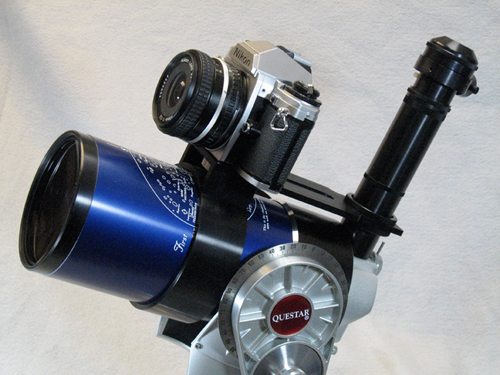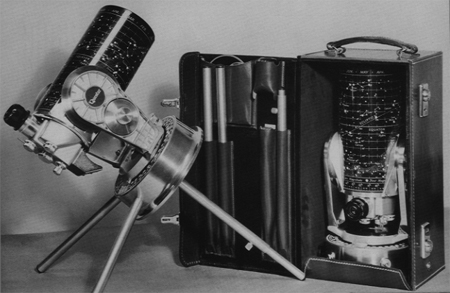Questar Distribution
![]() News
News ![]() Notes & Interesting Articles
Notes & Interesting Articles ![]() Overview
Overview ![]() Pricing
Pricing ![]() Products
Products ![]() Service or Repair
Service or Repair
Questar Telescopes ![]() LD Surveillance Systems
LD Surveillance Systems ![]() LD Microscopes
LD Microscopes ![]() Accessories
Accessories


PIGGYBACK MOUNT FOR QUESTAR 3-½ ASTRONOMICAL TELESCOPES
 The Questar 3-1/2 telescopes have been regarded as the finest compact telescopes of their class since they were introduced in 1954. These telescopes incorporate many features that make them handy and rewarding to use visually. However, over the past fifty years the Questar evolved into the first truly comprehensive system with accessories for both visual and for astrophotograhic pursuits. And so the Questar can also accept a broad range of accessories for imaging with film cameras, digital cameras, and CCD cooled cameras. Among the easiest ways to enter the realm of astrophotography with an astronomical model Questar is to employ the "Piggyback" technique, and for this Questar makes this superbly constructed accessory.
The Questar 3-1/2 telescopes have been regarded as the finest compact telescopes of their class since they were introduced in 1954. These telescopes incorporate many features that make them handy and rewarding to use visually. However, over the past fifty years the Questar evolved into the first truly comprehensive system with accessories for both visual and for astrophotograhic pursuits. And so the Questar can also accept a broad range of accessories for imaging with film cameras, digital cameras, and CCD cooled cameras. Among the easiest ways to enter the realm of astrophotography with an astronomical model Questar is to employ the "Piggyback" technique, and for this Questar makes this superbly constructed accessory.
Right: Questar 3-1/2 telescope with Piggyback Mount, and with optional and Questar Guiding Eyepiece attached and with a Nikon SLR camera (192,791 bytes). For simplicity, we do not show some of the recommended accessories discussed in this article.
Click on image to see enlarged view (347,212 bytes).
Piggyback photography is among the easiest astrophotography techniques, and by using this approach can achieve remarkable results. The Piggyback Mount is a set of machined aluminum hardware that supports a payload firmly in place atop the barrel of the Questar telescope. The payload is held into the platform by a 1/4-20 tpi bolt. So the payload can be a 35mm SLR (as shown here) or rangefinder camera, or it can be a digital camera with lens set to infinity focus, or it can be a CCD camera with lens. The telescope becomes the tracking platform that guides the payload along, with the lens of the attached device fixed onto a celestial target over a period of seconds, minutes, or even hours. This is among the best techniques for acquiring images of immense areas of sky; an entire constellation, or a large comet for examples will be among the best candidates for this comparatively low magnification method of astrophotography. And since the magnifications typically employed are so modest, the efforts to maintain precise tracking (guiding the telescope to compensate for Polar Alignment inaccuracy) are not as demanding as those of most other techniques. Incidentally, the Questar drive system lacks periodic error and so this is one less concern for the enthusiast.
The Earth rotates about its axis once full turn over a period of just under a day. As the Earth rotates in space the celestial objects overhead appear to move in an arc across the sky.
Left: Click image if you wish to see an animated movie of the Earth Rotating.
This is a Quicktime presentation courtesy of NASA, and so your Web Browser should be enabled to view it (3,491,793 bytes).
- Remove telescope Lens Shade.
- Remove telescope Eyepiece Holder. Carefully grasp the lower aluminum barrel and unthread the assembly counterclockwise.
- Attach the knurled Low Profile Adapter in place of the Eyepiece Holder.
- Slip the Piggyback Mount onto the front of the telescope holding this securely in place until it is secured by the following steps.
- Slide the bracket until the large open hole along the top rear of the Bracket is aligned with the Low Profile Adapter then thread the Retaining Collar through the opening atop the Piggyback Mount into the Low Profile Adapter.
- Attach the camera onto the Piggyback Mount with the captive stainless steel 1/4-20 tpi bolt. Adjust the camera forward or back on the Bracket to obtain the best balance before securing the bolt finger tight.
- Attach a remote control triggering device (Cable Release Cable, or electronic control) to the camera.
- Focus the camera for infinity. Refer to our article "Photography Using the Questar Telescope" for advice about focusing and other helpful hints.
- Attach the 4 inch long Guiding Eyepiece Extension Tube through the opening of the Retaining Collar and into the Low Profile Adapter. This provides clearance for the observer at the Guiding Eyepiece from the camera.
- Install an optional Guiding Eyepiece atop the Extension Tube. The Questar model threads in, while Company Seven can provide an adapter for slip fit 1.25 inch Guiding eyepieces.
- Guide by keeping the reference star in the center of the field of view of the telescope by using the fine adjustment control of the telescope (manual or by means of the Powerguide II Drive Corrector).
 The Equatorial Mount of the Questar rotates the telescope in the opposite direction from that which the Earth is rotating, at the same apparent speed as the Celestial objects are moving. This permits tracking in an arc sweeping in one smooth movement from East to West across the sky in the "Right Ascension" (R.A.) direction. To track precisely, the rotating Right Ascension Axis of the mount is adjusted up or down and left or right by the user so that this axis of the mount is parallel to the rotational axis of the Earth. For visual uses an equatorial mount will provide acceptable results even if the mount is aligned to only within about a few degrees of the Celestial Pole. But a more accurate alignment of the mount to the Celestial Pole is necessary for those persons who intend to attempt long exposure astrophotography or CCD imaging, and as you align the Mount more and more accurately then the need to periodically make minor adjustments to center a target in the eyepiece becomes less frequently.
The Equatorial Mount of the Questar rotates the telescope in the opposite direction from that which the Earth is rotating, at the same apparent speed as the Celestial objects are moving. This permits tracking in an arc sweeping in one smooth movement from East to West across the sky in the "Right Ascension" (R.A.) direction. To track precisely, the rotating Right Ascension Axis of the mount is adjusted up or down and left or right by the user so that this axis of the mount is parallel to the rotational axis of the Earth. For visual uses an equatorial mount will provide acceptable results even if the mount is aligned to only within about a few degrees of the Celestial Pole. But a more accurate alignment of the mount to the Celestial Pole is necessary for those persons who intend to attempt long exposure astrophotography or CCD imaging, and as you align the Mount more and more accurately then the need to periodically make minor adjustments to center a target in the eyepiece becomes less frequently.
Right: Early 1960's Questar Standard 3-½ telescope shown at left in Polar Aligned astronomical configuration on it's furnished Tabletop Tripod (Standard Center Leg), and also shown to the right stored in original Leather Carrying Case with standard accessories.
Click on image to see enlarged view.
The drive of a telescope is sometimes referred to as a "Clock Drive" since the earliest mechanical telescope drives were clock mechanisms modified to rotate only once every 24 hours. With the Questar, you can walk away from the telescope and come back later to find the telescope still on the target.
The Questar Fork Mount is basically an Alt-Azimuth mount, it moves up and down left and right, and so it can easily be used for terrestrial applications. For tracking in astronomical uses, the Fork Mount is fitted with either its tabletop tripod legs, or onto an Equatorial Wedge such as that on our Tristand. The Wedge has an adjustable Tilt Plate which is raised or lowered so that the R.A. rotational axis of the Fork can be aligned to the rotational axis of Earth.
Hints When using the Piggyback Mount start off simply, and with lower magnification or even wide angle lenses. While most people think telescopes need to operate at silly high magnifications, many celestial objects are so immense that many telescopes can not show or photograph them in one field. So keep in mind that to photograph any of the larger Constellations or Comets often requires using a wide angle lens on the order of 20 to 24mm and not much higher than normal 50mm lens on a conventional 35mm camera. However, many modern digital SLR cameras have detectors that are not as large as the traditional full frame cameras that were 24mm x 36mm x 43 mm. Company Seven recommends Canon as one of the few who make good full frame 35mm SLR digital cameras. And so when using the smaller format digital cameras understand you may have to use even lower focal length lenses.
Depending on the weight of the lens you can accommodate lenses of up to 100mm focal length, maybe more. To assist in focusing it is desirable to use relatively 'fast' lenses, with maximum ratios on the order of f/1.2, f/1.4, f2.0 for example. But when using fast lenses, the best star images are obtained with the lens stopped down a few stops or more from the maximum.
To lean how to calculate aspects including Field of View, drift errors, etc. refer to our article "Astronomical Forumalas for Telescopes".
QUESTAR PIGGYBACK BRACKET SPECIFICATIONS:
| Construction | Machined aluminum, black anodized. |
|---|---|
| Hardware | Stainless Steel |
| Guiding Eyepiece Port | Accepts Questar Brandon |
| Optional Port Adapter | accepts 1.25" Slip Fit eyepieces |
| Camera Position | Adjustable lengthwise along the top |
| Length Overall | 6-7/8 inches / 175mm |
| Weight | 12.3 Oz / 349 gr |
* Specifications given are as measured by Company Seven, subject change.
For more information about how to work your way through the decision making process of choosing and specifying a Questar 3-1/2 telescope, their common accessories, and desirable options please feel free to call us or send an E-mail inquiry, or visit our showroom. You may find more help by referring to the articles in our Questar Library section on line.
Contents Copyright 1994-2007 Company Seven All Rights Reserved


